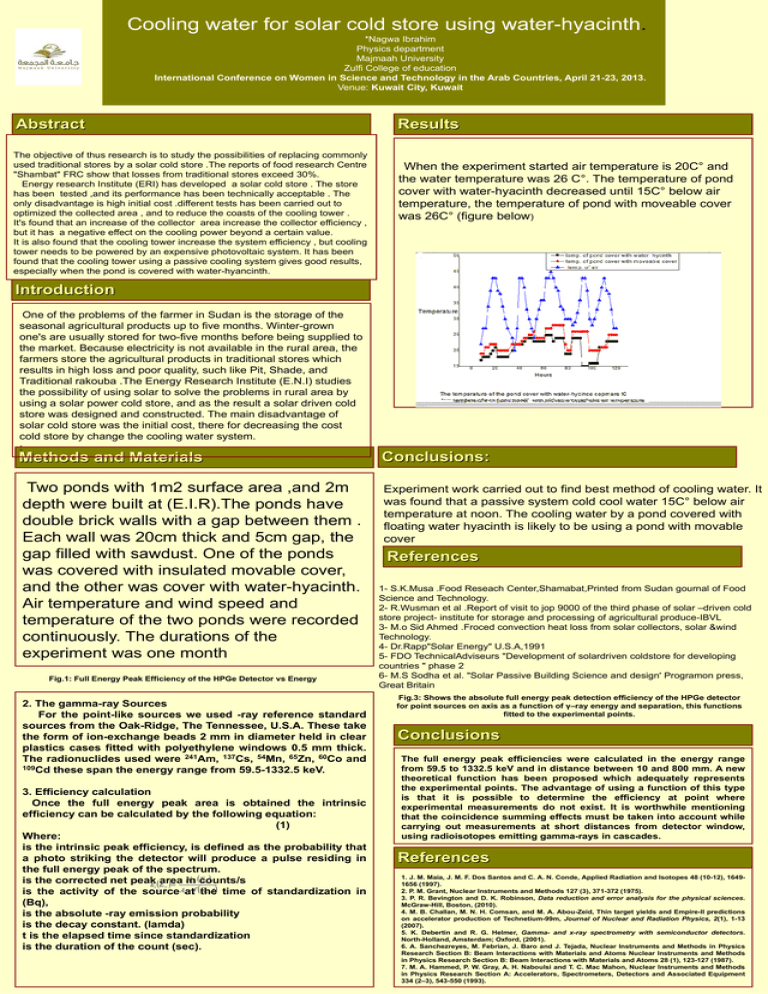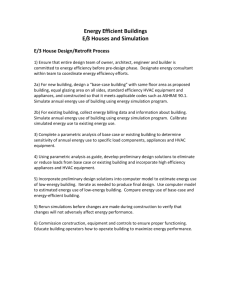48h x 30w poster template
advertisement

Cooling water for solar cold store using water-hyacinth. *Nagwa Ibrahim Physics department Majmaah University Zulfi College of education International Conference on Women in Science and Technology in the Arab Countries, April 21-23, 2013. Venue: Kuwait City, Kuwait Abstract The objective of thus research is to study the possibilities of replacing commonly used traditional stores by a solar cold store .The reports of food research Centre "Shambat" FRC show that losses from traditional stores exceed 30%. Energy research Institute (ERI) has developed a solar cold store . The store has been tested ,and its performance has been technically acceptable . The only disadvantage is high initial cost .different tests has been carried out to optimized the collected area , and to reduce the coasts of the cooling tower . It's found that an increase of the collector area increase the collector efficiency , but it has a negative effect on the cooling power beyond a certain value. It is also found that the cooling tower increase the system efficiency , but cooling tower needs to be powered by an expensive photovoltaic system. It has been found that the cooling tower using a passive cooling system gives good results, especially when the pond is covered with water-hyancinth. Results When the experiment started air temperature is 20C° and the water temperature was 26 C°. The temperature of pond cover with water-hyacinth decreased until 15C° below air temperature, the temperature of pond with moveable cover was 26C° (figure below) Introduction One of the problems of the farmer in Sudan is the storage of the seasonal agricultural products up to five months. Winter-grown one's are usually stored for two-five months before being supplied to the market. Because electricity is not available in the rural area, the farmers store the agricultural products in traditional stores which results in high loss and poor quality, such like Pit, Shade, and Traditional rakouba .The Energy Research Institute (E.N.I) studies the possibility of using solar to solve the problems in rural area by using a solar power cold store, and as the result a solar driven cold store was designed and constructed. The main disadvantage of solar cold store was the initial cost, there for decreasing the cost cold store by change the cooling water system. : Methods and Materials Conclusions: Two ponds with 1m2 surface area ,and 2m depth were built at (E.I.R).The ponds have double brick walls with a gap between them . Each wall was 20cm thick and 5cm gap, the gap filled with sawdust. One of the ponds was covered with insulated movable cover, and the other was cover with water-hyacinth. Air temperature and wind speed and temperature of the two ponds were recorded continuously. The durations of the experiment was one month Experiment work carried out to find best method of cooling water. It was found that a passive system cold cool water 15C° below air temperature at noon. The cooling water by a pond covered with floating water hyacinth is likely to be using a pond with movable cover Fig.1: Full Energy Peak Efficiency of the HPGe Detector vs Energy 2. The gamma-ray Sources For the point-like sources we used -ray reference standard sources from the Oak-Ridge, The Tennessee, U.S.A. These take the form of ion-exchange beads 2 mm in diameter held in clear plastics cases fitted with polyethylene windows 0.5 mm thick. The radionuclides used were 241Am, 137Cs, 54Mn, 65Zn, 60Co and 109Cd these span the energy range from 59.5-1332.5 keV. 3. Efficiency calculation Once the full energy peak area is obtained the intrinsic efficiency can be calculated by the following equation: (1) Where: is the intrinsic peak efficiency, is defined as the probability that a photo striking the detector will produce a pulse residing in the full energy peak of the spectrum. is the corrected net peak area in counts/s is the activity of the source at the time of standardization in (Bq), is the absolute -ray emission probability is the decay constant. (lamda) t is the elapsed time since standardization is the duration of the count (sec). References 1- S.K.Musa .Food Reseach Center,Shamabat,Printed from Sudan gournal of Food Science and Technology. 2- R.Wusman et al .Report of visit to jop 9000 of the third phase of solar –driven cold store project- institute for storage and processing of agricultural produce-IBVL 3- M.o Sid Ahmed .Froced convection heat loss from solar collectors, solar &wind Technology. 4- Dr.Rapp"Solar Energy" U.S.A,1991 5- FDO TechnicalAdviseurs "Development of solardriven coldstore for developing countries " phase 2 6- M.S Sodha et al. "Solar Passive Building Science and design' Programon press, Great Britain Fig.3: Shows the absolute full energy peak detection efficiency of the HPGe detector for point sources on axis as a function of γ–ray energy and separation, this functions fitted to the experimental points. Conclusions The full energy peak efficiencies were calculated in the energy range from 59.5 to 1332.5 keV and in distance between 10 and 800 mm. A new theoretical function has been proposed which adequately represents the experimental points. The advantage of using a function of this type is that it is possible to determine the efficiency at point where experimental measurements do not exist. It is worthwhile mentioning that the coincidence summing effects must be taken into account while carrying out measurements at short distances from detector window, using radioisotopes emitting gamma-rays in cascades. References 1. J. M. Maia, J. M. F. Dos Santos and C. A. N. Conde, Applied Radiation and Isotopes 48 (10-12), 16491656 (1997). 2. P. M. Grant, Nuclear Instruments and Methods 127 (3), 371-372 (1975). 3. P. R. Bevington and D. K. Robinson, Data reduction and error analysis for the physical sciences. McGraw-Hill, Boston, (2010). 4. M. B. Challan, M. N. H. Comsan, and M. A. Abou-Zeid, Thin target yields and Empire-II predictions on accelerator production of Technetium-99m, Journal of Nuclear and Radiation Physics, 2(1), 1-13 (2007). 5. K. Debertin and R. G. Helmer, Gamma- and x-ray spectrometry with semiconductor detectors. North-Holland, Amsterdam; Oxford, (2001). 6. A. Sanchezreyes, M. Febrian, J. Baro and J. Tejada, Nuclear Instruments and Methods in Physics Research Section B: Beam Interactions with Materials and Atoms Nuclear Instruments and Methods in Physics Research Section B: Beam Interactions with Materials and Atoms 28 (1), 123-127 (1987). 7. M. A. Hammed, P. W. Gray, A. H. Naboulsi and T. C. Mac Mahon, Nuclear Instruments and Methods in Physics Research Section A: Accelerators, Spectrometers, Detectors and Associated Equipment 334 (2–3), 543-550 (1993).





